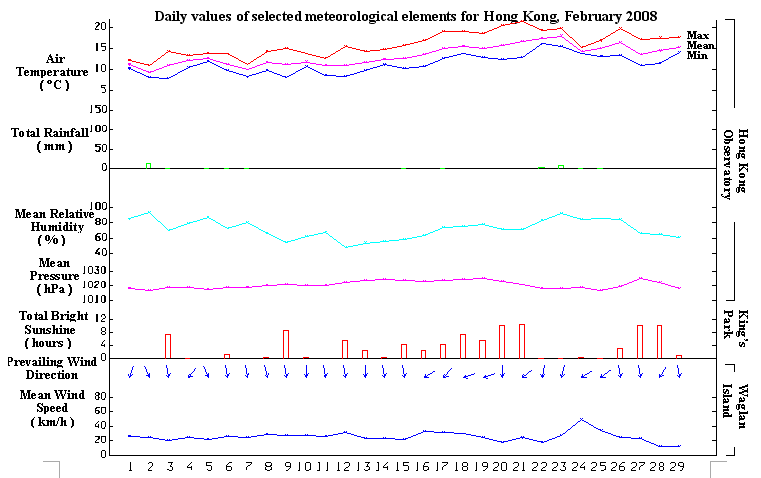The Weather of February 2008
|
February 2008 was much colder than usual. The monthly mean temperature of 13.3 degrees was 3.0 degrees below normal, the lowest for February in the past 40 years. The total rainfall in the month was 27.5 millimetres, about 47 percent below normal. Under the influence of an intense northeast monsoon, the cold spell which started on 24 January persisted for 24 days until 16 February. This was the longest cold spell in 40 years. The minimum temperature fell to 7.9 degrees on 3 February, the lowest so far this winter. Except for the sunny periods on 3 and 9 February, the weather was generally cloudy with rain patches in the first seventeen days of the month. With the moderation of the northeast monsoon, the weather became mainly fine and dry on 18 February. The generally fine and dry weather continued for the ensuing three days. A broad cloud band over south China brought cloudy and rainy conditions to the territory from 22 to 26 February. After the passage of a cold front across the south China coast on 26 February, the weather became cold, fine and dry on 27 and 28 February. A cloud band moved across Guangdong from west to east and brought cloudy weather to Hong Kong on the last day of the month. There was no tropical cyclone over the South China Sea and the western North Pacific in the month. |
|
Details of issuance and cancellation of various warnings/signals in the month are summarized in Tables 1.1 to 1.4. Monthly meteorological figures and departures from normal for February are tabulated in Table 2. |
Warnings and Signals issued in February 2008
| Beginning Time | Ending Time | ||
|---|---|---|---|
| Day/Month | HKT | Day/Month | HKT |
| 18 / 2 | 0130 | 18 / 2 | 0535 |
| 23 / 2 | 1945 | 25 / 2 | 1145 |
| 26 / 2 | 1700 | 27 / 2 | 0915 |
| Colour | Beginning Time | Ending Time | ||
|---|---|---|---|---|
| Day/Month | HKT | Day/Month | HKT | |
| Yellow | 3 / 2 | 0600 | 4 / 2 | 0600 |
| Yellow | 6 / 2 | 1200 | 6 / 2 | 2330 |
| Yellow | 7 / 2 | 1130 | 9 / 2 | 0600 |
| Red | 9 / 2 | 0600 | 11 / 2 | 1600 |
| Red | 12 / 2 | 0600 | 15 / 2 | 2330 |
| Yellow | 17 / 2 | 1115 | 17 / 2 | 1800 |
| Yellow | 18 / 2 | 1200 | 18 / 2 | 2300 |
| Yellow | 20 / 2 | 0600 | 21 / 2 | 2115 |
| Yellow | 27 / 2 | 0600 | 27 / 2 | 2315 |
| Yellow | 28 / 2 | 0600 | 1 / 3 | 0600 |
| Beginning Time | Ending Time | ||
|---|---|---|---|
| Day/Month | HKT | Day/Month | HKT |
| 9 / 2 | 1630 | 10 / 2 | 0745 |
| Beginning Time | Ending Time | ||
|---|---|---|---|
| Day/Month | HKT | Day/Month | HKT |
| 24 / 1 | 1500 | 18 / 2 | 0930 |
| 26 / 2 | 1620 | 28 / 2 | 1130 |
| Meteorological Element | Figure of the Month | Departure from Normal* |
|---|---|---|
| Mean Daily Maximum Air Temperature | 16.0 degrees C | 2.6 degrees below normal |
| Mean Air Temperature | 13.3 degrees C | 3.0 degrees below normal |
| Mean Daily Minimum Air Temperature | 11.3 degrees C | 3.1 degrees below normal |
| Mean Dew Point Temperature | 8.1 degrees C | 4.1 degrees below normal |
| Mean Relative Humidity | 72 % | 6 % below normal |
| Mean Cloud Amount | 72 % | 1 % below normal |
| Total Rainfall | 27.5 mm | 24.8 mm below normal |
| Number of hours of Reduced VisibilityΔ | 316 hours | 185.7 hours above normal§ |
| Total Bright Sunshine Duration | 96.8 hours | 3.0 hours above normal |
| Mean Daily Global Solar Radiation | 10.16 Megajoule / square metre | 0.55 Megajoule above normal |
| Total Evaporation | 63.2 mm | 4.4 mm below normal |
| Remarks : | All measurements were made at the Hong Kong Observatory except sunshine, solar radiation and evaporation which were recorded at King's Park Meteorological Station and visibility which was observed at the Hong Kong International Airport. |
| Δ |
The visibility readings at the Hong Kong International Airport are based on hourly observations by professional meteorological observers in 2004 and before, and average readings over the 10-minute period before the clock hour of the visibility meter near the middle of the south runway from 2005 onwards. The change of the data source in 2005 is an improvement of the visibility assessment using instrumented observations following the international trend. |
* Departure from 1971 - 2000 climatological normal, except for number of hours of reduced visibility |
|
§ Departure from mean value between 1997 and 2007 |
|
